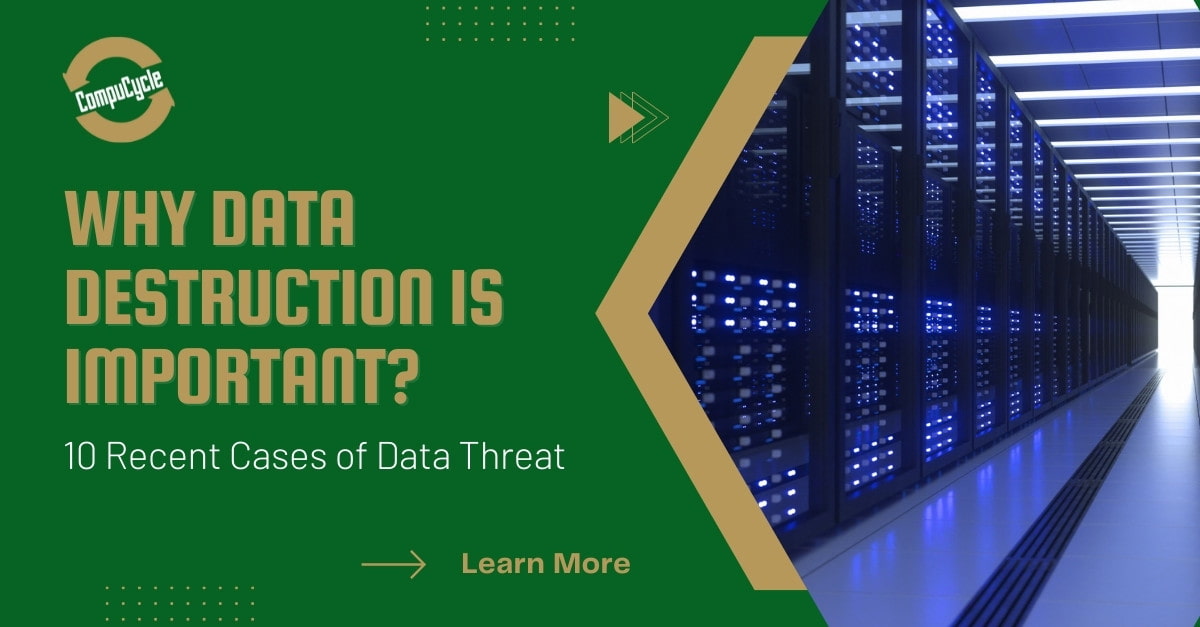Data Destruction Solutions: A Key Element in Your Cyber Security Technique
Wiki Article
The Essential Nature of Information Damage in Upholding Computer Protection Services and Protecting Against Unauthorized Access
In an era where data breaches and identity theft are increasingly widespread, the relevance of reliable data destruction can not be overstated. Different approaches, from data cleaning to physical devastation, serve as important safeguards versus unauthorized accessibility.Value of Data Damage
In an increasingly electronic globe, the significance of data devastation can not be overemphasized. As organizations amass large amounts of sensitive details, the prospective repercussions of falling short to appropriately handle and get rid of of that information come to be significantly extreme. Information violations, identification theft, and company espionage posture substantial risks, emphasizing the requirement of reliable data destruction techniques.
Additionally, as innovation progresses, so as well do the techniques through which destructive stars seek to manipulate delicate information. Organizations has to stay alert and aggressive in their data destruction strategies to guard versus these evolving hazards. By prioritizing information destruction, business not just protect their properties yet additionally foster count on among clients and stakeholders, demonstrating a commitment to liable information management and protection techniques.
Methods of Effective Information Destruction
To guarantee the complete and permanent destruction of delicate information, organizations can use a selection of effective approaches tailored to their certain requirements. One of the most typical approaches is information wiping, which includes using specialized software to overwrite existing data numerous times, making healing virtually impossible. This is especially helpful for disk drives and solid-state drives, where standard deletion approaches are insufficient.One more effective technique is degaussing, which makes use of solid magnetic areas to interrupt the magnetic domains on storage space media, providing the data irretrievable. This method is particularly matched for magnetic storage devices, such as disk drive and tough disks.
Physical devastation is likewise a sensible option, involving the shredding, crushing, or incineration of storage gadgets. This technique guarantees that data can not be recuperated, making it ideal for companies taking care of highly delicate details.

Compliance With Information Protection Rules
Organizations should not just focus on reliable information destruction methods however also make sure conformity with data security guidelines that control exactly how delicate details is taken care of and thrown away. Following these regulations is vital for protecting individual information and maintaining customer trust. Rules such as the General Information Security Regulation (GDPR) in the European Union and the Medical Insurance Mobility and Accountability Act (HIPAA) in the United States enforce strict guidelines on information administration, that include demands see page for the secure disposal of delicate details.To accomplish conformity, companies should apply extensive information destruction plans that line up with these lawful frameworks. This includes recognizing information that requires destruction, developing protocols for protected methodsâEUR" such as shredding physical media or utilizing software that satisfies sector requirements for information wipingâEUR" and preserving comprehensive documents of damage activities. Regular audits must be conducted to guarantee adherence to these plans and to determine any kind of possible areas for improvement.
Failing to adhere to information defense policies can bring about substantial lawful ramifications, consisting of large fines and damages to a company's online reputation. Therefore, incorporating compliance into data damage methods is not only a legal responsibility yet additionally a critical part of a robust information safety method.
Repercussions of Poor Information Handling
Poor information handling can lead to extreme effects that expand beyond immediate functional obstacles. Organizations may encounter significant monetary losses as a result of information violations, which commonly lead to costly removal initiatives, legal charges, and regulative penalties. These financial effects can prevent and stress sources growth, inevitably influencing an organization's profits.
In addition, bad information handling can severely harm an organization's reputation. Companions, customers, and stakeholders may lose count on an entity that falls short to shield sensitive details, causing decreased client commitment and possible loss of service possibilities. This erosion of trust can take published here years to rebuild, if it can be recovered in all.
In addition, companies might encounter legal ramifications emerging from non-compliance with data security laws. Such infractions might result in investigations and charges, worsening the economic problem and more tainting the company's picture.
In the realm of cybersecurity, poor information management techniques can create susceptabilities that make systems a lot more susceptible to unapproved accessibility and cyberattacks. Inevitably, these consequences highlight the crucial relevance of applying durable data managing procedures to secure delicate info and keep business stability.
Finest Practices for Secure Data Disposal


First of all, data need to be identified according to its level of sensitivity. Delicate info calls for a lot more rigorous disposal techniques, such as shredding physical files and using innovative software application for digital information cleaning. Utilizing certified data destruction solutions ensures conformity with market policies and requirements.
Second of all, organizations should execute an information disposal plan that mandates normal audits. This policy ought to detail the procedures for data retention and damage, ensuring that outdated information is dealt with promptly and securely. Training staff members on these methods is vital to promoting a culture of protection understanding.
Last but not least, keeping comprehensive documents of disposed information improves liability and provides a clear audit trail. This documents should consist of the type of data ruined, the method made use of, and the day of disposal.
Conclusion
Taking on robust approaches such as data cleaning, degaussing, and physical devastation, together with conformity with regulations like GDPR and HIPAA, is vital for protecting sensitive information. Overlooking correct information disposal practices can lead to serious repercussions, including information violations and legal consequences.In an era where data violations and identity theft are increasingly widespread, the significance of reliable data devastation can not read this post here be overstated. data destruction. Information violations, identification theft, and company espionage position substantial dangers, highlighting the requirement of reliable information damage techniques
Compliance with guidelines such as GDPR and HIPAA mandates that organizations apply strict information defense procedures, consisting of the secure devastation of information at the end of its lifecycle.
By prioritizing information damage, business not just secure their properties but likewise foster trust fund amongst stakeholders and clients, showing a dedication to responsible data administration and safety and security practices.
Organizations need to not only concentrate on efficient data damage techniques however also make sure compliance with data security regulations that regulate exactly how delicate information is managed and disposed of.
Report this wiki page